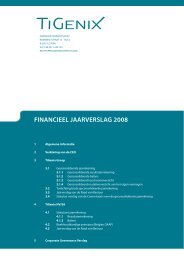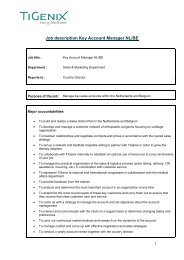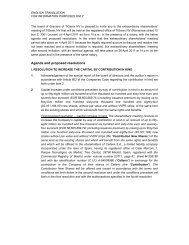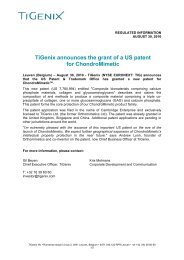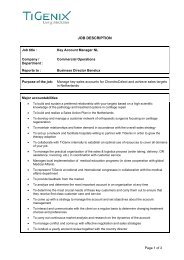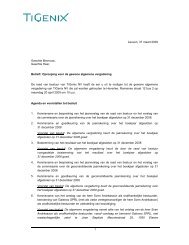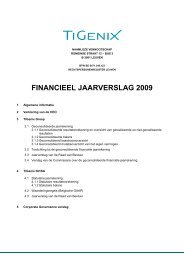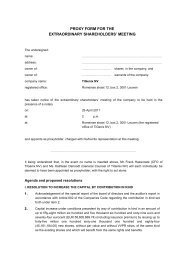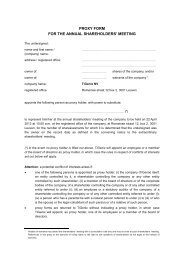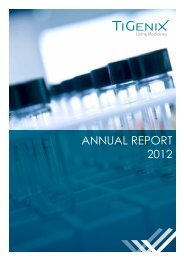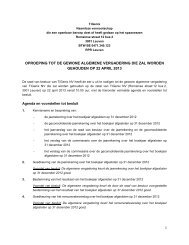ANNUAL FINANCIAL REPORT 2010 2010 - TiGenix
ANNUAL FINANCIAL REPORT 2010 2010 - TiGenix
ANNUAL FINANCIAL REPORT 2010 2010 - TiGenix
- No tags were found...
You also want an ePaper? Increase the reach of your titles
YUMPU automatically turns print PDFs into web optimized ePapers that Google loves.
For some market opportunities, the Company may need toenter into co-development, co-promotion or other licensingarrangements with larger pharmaceutical or medical devicefirms in order to increase the chances of commercial successof its products. An example hereof is the ongoing searchfor co-development and commercialisation partners forChondroCelect and ChondroMimetic outside Europe. <strong>TiGenix</strong>may not be able to establish sales, marketing and distributioncapabilities of its own or to enter into arrangements withcontract sales organisations or larger pharmaceutical or medicaldevice firms in a timely manner or on acceptable terms.Additionally, building marketing and distribution capabilitiesmay be more expensive than <strong>TiGenix</strong> anticipates, requiring itto divert capital from other intended purposes or preventing itfrom building its marketing and distribution capabilities to thedesired levels.<strong>TiGenix</strong>’ dependence on third parties may reduce itsprofit margins and delay or limit its ability to develop andcommercialise its products on a timely and competitive basis.<strong>TiGenix</strong> may not be able to adequately protectits proprietary technology or enforce anyrelated rights thereto.<strong>TiGenix</strong>’ ability to compete effectively with other companiesdepends, amongst other things, on exploitation of itstechnology. However, there can be no assurance thatcompetitors have not developed or will not developsubstantially equivalent technologies or otherwise gain accessto <strong>TiGenix</strong>’ technology. To date, <strong>TiGenix</strong>’ patent applications areprogressing through the examination process.<strong>TiGenix</strong> has been granted its three core patents in theEuropean Union, and four patents in the U.S. with regard tothe regenerative medicine portfolio. An additional patentfamily has been granted in Europe, the US, Australia, Japanand Taiwan for the Cx501 dermal platform. There can be noassurance that further patents will be issued with respect to<strong>TiGenix</strong>’ applications now pending or which may be appliedfor in the future. The lack of any such patents may have amaterial adverse effect on <strong>TiGenix</strong>’ ability to develop andmarket its proposed products. No assurance can be given that<strong>TiGenix</strong> will develop products which are patentable or thatits current or future patents will be sufficiently broad in theirscope to provide commercially meaningful protection againstcompetition from third parties. There can be no assurance asto the validity or scope of any patents which may be issued to<strong>TiGenix</strong> or that claims relating to its patents will not be assertedby other parties or that, if challenged, <strong>TiGenix</strong>’ patents will notbe revoked. Even if competitors do not successfully challenge<strong>TiGenix</strong>’ patents, there can be no guarantee that they will notbe able to design around <strong>TiGenix</strong>’ patents or develop uniquetechnologies or products providing effects similar to <strong>TiGenix</strong>’,which may decrease the Company’s future potential revenues.<strong>TiGenix</strong>’ development stage product Cx601 was grantedorphan drug designation by the EMA in 2009. In addition toother significant benefits, in general if a product with orphandrug designation in the European Union subsequently receivesthe first marketing approval for the indication for which ithas such designation, the product is entitled to a period ofmarketing exclusivity of 10 years, which precludes the EMAfrom approving another marketing application for the samedrug for that time period. However, this form of protection isconsidered to be less robust than that provided by compositionof matter patents. It does not extend to any indications beyondthat for which orphan drug status was granted, and is subjectto certain limitations. As such, there can be no guaranteethat <strong>TiGenix</strong> could rely on or benefit from the commercialprotection potentially afforded by orphan drug designation forthis product.If the Company’s intellectual property rights, trade secretsand know-how are infringed, litigation may be necessaryto protect the Company’s intellectual property rights, tradesecrets and know-how, which could result in substantial coststo, and diversion of efforts by, the Company with no guaranteeof success. The Company’s attempts to obtain patent or otherprotection for certain part of its products and/or technologiesmay also be subject to opposition, in relation to which theCompany may need to incur substantial costs to overcome,with no guarantee of success. The Company may also decideto engage in costly opposition or interference proceedingsto prevent third parties obtaining relevant patent or otherprotection, again with no guarantee of success.<strong>TiGenix</strong> could be prevented by third partypatents to develop or exploit its products.The commercial success of <strong>TiGenix</strong> depends upon its noninfringementof patents granted to, and other intellectualproperty rights of, third parties, including any who may havefiled applications or who have obtained or may obtain patentsrelating to products which might inhibit <strong>TiGenix</strong>’ ability todevelop or exploit its own products. Additionally, as patentapplications, in general, are not published until 18 months afterthe date of priority applications or, in some cases in the U.S.,until grant, the Company cannot be certain that it was the firstto make, or seek patent protection for, the invention claimed30 • <strong>TiGenix</strong> • Rights Offering



